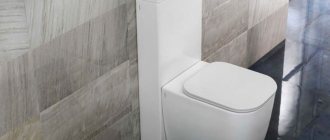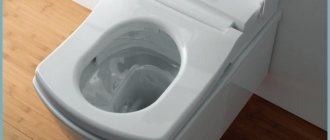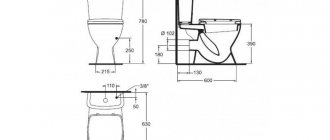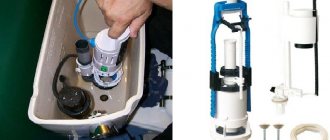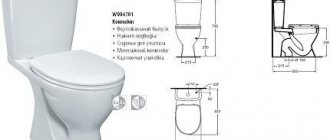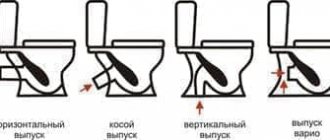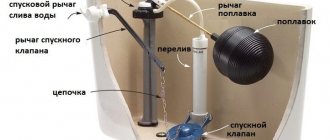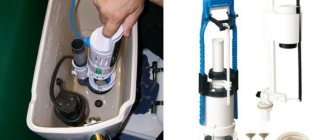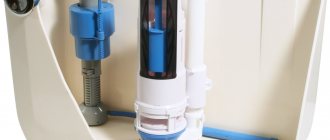For most plumbing buyers, the phrase “toilet without a tank” means that the tank is not included with the bowl and must be purchased separately. And for online stores, the answer to such a request will be unambiguous - they will show exactly the same bowls for floor or wall installation. Which drainage device will be selected for it depends only on the client’s wishes (and, of course, on the compatibility of the units).
In total, there are four options for how to equip a toilet: a wall-mounted cistern (hanging, high-level), a compact cistern, a built-in cistern and a drukspüller. It is the latter option that is “tankless”.
What does the system look like without a tank?
When installed and already functioning, a toilet without a flush cistern may look different - the appearance depends on the method of installing the bowl and the flush device itself.
If the toilet is wall-hung, then the tankless flush system can only be built-in. One drain button will be located on the surface of the wall or sheathed frame structure. And this type of system with a dryer is similar in appearance to a console toilet with an installation or a built-in cistern.
The floor-standing toilet can be equipped with either a built-in tankless flush system or an external one. Externally, the external drainer resembles a common system for a urinal, when a chrome-plated or painted tube with a flush lever (or button) comes out of the wall towards it. And if we talk about the principle of operation and internal structure, then they are similar and both relate to drain devices operating under pressure.
What is special about installing floor plumbing
Installation of a toilet without a flush tank occurs in the same way as connecting a traditional device to the sewer network. The difference lies in the water wiring.
They are performed in the following sequence:
- Moving communications is unprofitable, so the installation is carried out at the location of the previous device. When work requires, for various reasons, the displacement of a plumbing mechanism or its installation in another area, cold water supply to that point is required. Its location must be calculated, placed in the middle of the toilet and at a height of 90 cm from the floor surface.
- For wiring, grooves are hollowed out in the wall, then it will take time and skill to seal it. Correct selection of pipe diameters is important. Installing a plug on the supplied pipe before finishing is completed.
- Having removed the deformation of the wall, after gating, they begin to install the plumbing, choosing any option you like. A floor model without a tank is suitable for fixing on the wall.
- The compact device is mounted near the toilet. Connect the standing elbow to the drukspühler. First remove the plug from the pipe. The ends are connected with a union nut, lightly screwed in by hand, then, using a wrench, the fixation is secured. The same fasteners are used to connect the pipe, the dryer and the toilet in sequence.
After installation, you should check the operation of the mechanism by turning on the water. Plumbing specialists believe that the process of installing toilets without a tank is much easier than working with a flush tank. They are grateful to the pedantic German developers who took into account all the small nuances.
Internal structure of the drukspüller
A tank is a storage tank and the required water pressure is provided simply by the natural pressure of the “water column”. The flushing function of the drukspüller depends on the pressure in the water supply network and the design of the toilet bowl.
This is the difference between a drukspüller and a cistern - it is a kind of membrane tap that connects a tankless toilet to a water pipe. The principle of operation of a druckspüller is the same as that of a straight-through diaphragm valve. The drukspüdder works both as a shut-off valve with an “open/close” function, and as a flow regulator - in drain mode, it remains open for a certain time, designed to pass a given volume of liquid.
The internal structure of the drukspüller is more complex than that of a conventional crane. Although it also has two chambers connected by a passage hole with a shut-off valve. A water pipe is connected to the first chamber through a side outlet, and a drain elbow, which is inserted into the toilet, is connected to the second chamber. The design feature of the drukspüller is that it is opened manually, and it closes automatically. It is in the first chamber that the cartridge is “packed”, separated by a membrane. A spring-loaded shut-off valve rod “walks” inside the cartridge.
Non-specialized information
Advantages
The main advantage of toilets without a tank is their attractiveness, since all its communications are hidden behind the wall. Based on this, they look unusual and modern, thanks to which the bathroom gets a completely different look.
In addition, such plumbing equipment also has some other advantages:
- The design is smaller than a classic toilet, which allows you to save space in the bathroom.
- Good hygiene, since such a plumbing fixture is easier to clean.
- Due to the absence of a tank, the room visually expands.
- Suspended structures allow you to wash the floor under the toilet.
It is precisely thanks to all these points that products without a tank have become widespread among owners of houses and apartments. Moreover, they are especially relevant in Soviet apartments with small bathrooms.
Flaws
As is not uncommon in most cases, along with the advantages, the products under consideration also have some disadvantages:
- The installation is difficult, especially for wall-mounted toilets, since they require a great installation.
- Higher price than classic plumbing.
- Difficulty in maintenance and repair, since in this case it will be necessary to damage the finishing of the room.
In general, the shortcomings are not so serious as to abandon the idea of using this plumbing fixture.
Features: pros and cons
Advantages:
- versatility - such a drainage system is suitable for equipping a bathroom in any building: residential, public, municipal, industrial;
- no need to wait until the tank is filled to use the flush again;
- water flows and makes noise only during flushing;
- all three installation options are provided: external, built into the wall or in an installation;
- minimal dimensions in any design - an external flush system without a tank allows you to save space.
There is only one drawback - there is no water supply, like a tank. And when the water is turned off, you can only flush the toilet manually if the water is stored in some other container.
Cost-effectiveness of plumbing products
The Germans provided a stable water flow with a button device in which there are two sectors with economical flushing. The built-in buttons regulate the drainage to three or six liters.
Some developers offer new models that fix the required displacement. Private owners use such mechanisms in their homes, where water is supplied using pumps.
There is no need to worry about repairing a foreign new product, since there are so few built-in elements that the possibility of something breaking is small, including the actuator. When this happens, you just need to reach the button, unscrew it and replace it with a new cartridge.
Types of toilets without a tank
Drukshpullers are designed for two types of bowls: funnel-shaped and plate-shaped.
According to the method of installing the toilet, they are suitable for all types: floor-standing, console and attached.
Floor standing toilets
Manufacturers of external dryers for each model include instructions and a diagram for installing the system. The differences between them are in details, but the general principles of installation are the same:
- mark on the wall the place for cutting under the water pipe;
- lay a pipe to the connection point;
- from the floor level to the outlet of the adapter for connecting to the water supply should be about 1 m (950-1050 mm for a Grohe druckspuller, 890-1064 mm for a Schell);
- distance from the wall to the toilet flush hole - 140 mm;
- the drukspüller body is held in place by the transition pipe between it and the water pipe;
- to fix the drain pipe to the wall in the form of an elbow, one standard bracket is provided, holding it approximately in the middle;
- the third point of “support” of the system is the toilet drain hole.
Note. Hidden communication wiring can be carried out under the sheathing or in a plasterboard partition;
Installation of the pressure flush system takes place after finishing work is completed and the toilet is installed.
The sequence of work is as follows:
- The water is first drained - the pipeline is washed to remove any debris that may have entered during the work (a mechanical filter for coarse and fine cleaning in the water supply system must be required).
- Connect the dryer to the water supply.
- Cut the drain pipe so that it does not reach 20 mm from the drukspüller body. Insert the pipe into the toilet with its elbow.
- Install the adapter tube with a nut into the drain pipe from the side of the cut edge.
- Connect the drukshpuller with the adapter tube with a nut.
- Turn on the system, check it for leaks and operability.
- If necessary, remove the cover from the drainer and adjust the flush volume using the adjusting screw.
How to choose a splash-free toilet
Having chosen a toilet that suits your design and parameters, do not forget about such a nuisance as splashes. They are annoying both during use and during rinsing.
The presence of splashes or their absence depends on several factors: the shape of the toilet bowl, the location of the drain hole, the water level in the drain hole, and the habits of the toilet owner. The “non-splashing” shapes of bowls are discussed above, and we will consider other factors in more detail.
Anti-splash system
Unscrupulous sellers in plumbing stores try to install an anti-splash system almost everywhere, even if the toilet design is not equipped with it.
Operation of the anti-splash system
Advice. You can recognize the “anti-splash” yourself by visually inspecting the toilet model, and not fall for the seller’s deception.
First of all, “anti-splash” is the special geometry and location of the drain hole:
- The drain hole is narrowed.
- The drain hole is “recessed” as deep as possible.
- Displacement of the drain hole in any direction relative to the axis of symmetry of the toilet.
- The water level in the drain hole is significantly reduced.
In addition to the location of the drain hole, “anti-splash” assumes the presence of a circular rim, which additionally holds back splashes. It is these parameters that characterize the presence of “anti-splash” in the toilet, regardless of the manufacturer, shape and color of the plumbing fixtures.
How to determine the water level in an unplugged toilet
It is very simple to independently determine the water level in the toilet while still in the store. To do this, it is enough to recall the school physics curriculum, namely, the law of communicating vessels:
Determining the water level in the toilet
- Locate the bottom point of the outlet.
- Draw a mental line along the toilet parallel to the floor. This is exactly what the water level in the toilet will be, and the lower it is, the less splashing there will be.
Manufacturers and flush features
As was clear from the text above, two German companies are represented on our market of drainage pressure devices: Grohe and Schell. Both have systems for external and built-in installation, including a frame for installation.
In the usual version, the drainage system is designed for water pressure from 1.2 to 5 bar. But there are models aimed at low pressure: Grohe has 0.6-3 bar, Schell has 0.8-2.5 bar. The flow rate that both companies claim is in the range of 1-1.3 l/s, and with a standard volume setting of 6 liters, the flush time does not exceed 6 seconds.
Another example of an external drainer is the Serim C-153F siphon toilet for public toilets. Despite the two units, this is a kit, and the model is sold as a “monoblock”. The peculiarity of the flush device is that it has a more complex geometry, and the plumbing fixture is placed offset relative to the point of connection to the water supply.
What are the good and what are the disadvantages of flushing systems?
Druckspühler on the toilet
Despite the fact that a tankless flush system saves quite a lot of space in the toilet, in combination with other advantages, the disadvantages outweigh the advantages of such an installation.
They are the reason why tankless plumbing is not installed in residential complexes.
Public bathrooms have become their main consumers.
In such toilets, it is necessary to flush a lot of sewage, and the large traffic flow of people requires continuous flushing without waiting for the tank to be filled with liquid.
What are the disadvantages of the installation that affect the large growth of consumers:
- The German creators have no shortcomings in the work of public utilities in residential areas. Frequent water interruptions in our homes pose a flushing problem when the tank is always full.
- To operate a trouble-free dryer, you only need a good supply of water through water pipes, with normal pressure, regardless of the time of year or day. There are no pumps for high-rise buildings in our country; only with their help can water pressure be normalized. If residents of the lower floors do not experience problems with water, then the upper floors sometimes suffer from a lack of fluid in the evening. For the normal functioning of the system, a regular supply of water resources with a pressure of at least 1.5 atm is necessary.
- At the time of flushing, many consumers find the operation of a tankless system too noisy. There is a lot of debate about what works louder, built-in tanks or systems without them, until they came to a consensus.
Interaction disadvantages outweigh public opinion, although their ability to not collect condensation is a good feature for plumbing fixtures. Drain tanks because there is always water there, which is drained, collected, and forms dampness on the walls of the device.
